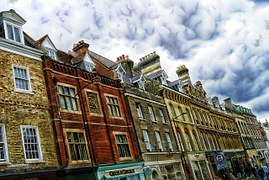Living in an historic property is both a joy and a privilege. Anyone lucky enough to be in this situation has a duty to make use of all available modern preservation techniques in order to pass on the architectural legacy for the appreciation of subsequent generations.
Repainting
One of the first projects tackled in an old home is often repainting. If the goal is to reproduce a color scheme as close as possible to the original, modern technology may be used by a paint investigation specialist to subject samples retrieved from the property to cross-section analysis and chemical and fluorescent staining. This process is described at Oldhouseweb, where new paints and techniques for old properties are discussed in great detail.
Lead content
One of the problems with old paint is its lead content, and once again new techniques are required when removing the old paint layer, in the form of protective hazard suits to guard against contact with the toxic lead dust.
Exterior woodwork in old houses, such as door and window frames, can be beyond repair, especially if the property is located close to the seashore. It is possible to purchase low maintenance replacement double-hung sash windows clad in extruded aluminum, molded to give the appearance of traditional wood and fitted with insulating glass.
Rust
Thanks to modern technology, contemporary homeowners have products on hand that were not available when the house was built. For example, an old tin ceiling with rust problems can have gaps sealed with latex caulk before being treated with a rust preventing primer followed by a coat of oil-based paint.
Energy efficiency
Geothermal technology can be used to produce energy-efficient heating and cooling systems which exchange heat with the earth to regulate indoor air temperature. This is achieved by circulating fluid in a series of underground pipes. For historic properties, often found on small inner-city lots, the pipes can be installed vertically, and even underneath the building.
Rewiring
Rewiring an old home to 21st century standards is one of the biggest challenges facing the owner of an historic property. Fortunately it is possible to achieve rewiring of an old dwelling to accommodate hi-tech internet, home entertainment, environmental control and security solutions. This can be done with minimum disruption by installing a two inch diameter PVC pipe in the wall cavity from the attic down to the basement, to allow sophisticated cabling to be pulled through to each floor.
Renovating historic homes around the world
The challenge of adapting modern technology to old houses is not confined to north America. In England, social housing from the 19th century has been updated by retro-fitting sash windows with insulating glass and installing super dense insulation, heat exchanger and energy efficient boilers. An Australian website discusses the benefits of applying a clear powder coat to a brass gaslight to avoid constant cleaning, as well as the kiln refiring of scratched and worn decorative tiles.
Any person who has lived in an old house will tell you that it is first and foremost a home and not a museum. Prized for its history and character, it nevertheless needs to be a comfortable and efficient dwelling adapted to the needs of its 21st century residents. By adapting modern technologies in a non-intrusive way it is possible to enjoy the amenities of today without destroying the charm of yesteryear

